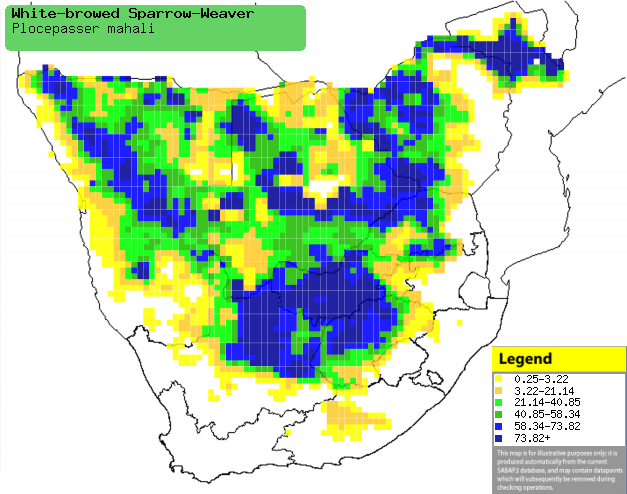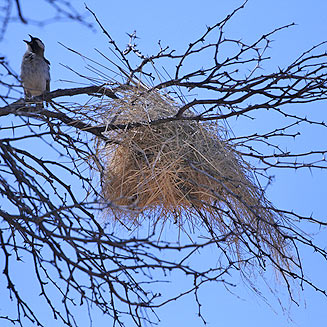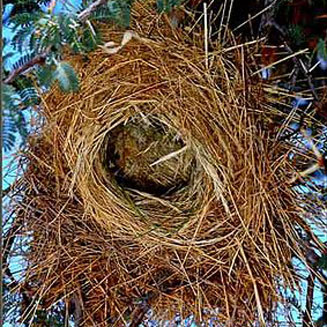|
Plocepasser mahali
(White-browed sparrow-weaver)
KoringvoŽl [Afrikaans]; Mogale [Tswana];
Mahali-wever [Dutch]; Mahali ŗ sourcils blancs [French]; Mahaliweber
[German]; Tecel„o-pardal [Portuguese]
Life
> Eukaryotes >
Opisthokonta
> Metazoa (animals) >
Bilateria >
Deuterostomia > Chordata >
Craniata > Vertebrata (vertebrates) > Gnathostomata (jawed
vertebrates) > Teleostomi (teleost fish) > Osteichthyes (bony fish) > Class:
Sarcopterygii (lobe-finned
fish) > Stegocephalia (terrestrial
vertebrates) > Tetrapoda
(four-legged vertebrates) > Reptiliomorpha > Amniota >
Reptilia (reptiles) >
Romeriida > Diapsida > Archosauromorpha > Archosauria >
Dinosauria
(dinosaurs) > Saurischia > Theropoda (bipedal predatory dinosaurs) >
Coelurosauria > Maniraptora > Aves
(birds) > Order: Passeriformes
> Family: Ploceidae
Distribution and habitat
It mainly occurs in two separate areas of sub-Saharan
Africa; one extending from Ethiopia through Somalia and Kenya to Tanzania, with
a larger population from Zambia to Tanzania south to southern Africa. Here it is
locally common to abundant across much of the region, excluding most of
Mozambique and the southern and eastern provinces of South Africa. It generally
prefers semi-arid Acacia and Mopane (Colosphermum mopane) savanna
woodland, especially along the border between degraded and undisturbed habitat.
|
 |
|
Distribution of White-browed sparrow-weaver in southern Africa,
based on statistical smoothing of the records from first SA Bird Atlas
Project (©
Animal Demography unit, University of
Cape Town; smoothing by Birgit Erni and Francesca Little). Colours range
from dark blue (most common) through to yellow (least common).
See here for the latest distribution
from the SABAP2. |
Predators and parasites
It (at various stages of development) has been recorded as
prey of the following animals:
- Adults
- Eggs, chicks and fledglings
Food
It mainly eats insects, seeds, fruit and fleshy leaves,
doing most of its foraging in flocks of 4-10 birds (sometimes along with other
species), plucking food items from the ground. The following food items have been recorded
in its diet:
- Insects
- Plants
- seeds
- Stipagrostis (bushman grass)
- Uruchloa (signal grasses)
- Triticum (wheat)
- Zea mays (maize)
- fruit
- fleshy leaves
Breeding
- Monogamous, colonial cooperative breeder, living in groups within which
each bird has their own nest. However there can only be one active breeding
pair per group who are usually the largest in size, remaining dominant until
their death, at which point another pair steps up to the plate. The group
are highly territorial, vigorously defending their ca. 50 metre long
foraging territory, often chasing intruders out of the territory.
- The nest (see images below) is built by both breeders in about 5-30 days
but maintained throughout the year, consisting of an untidy, retort-shaped
structure made of dry grass, with two entrances one of which is closed by
the breeding pair. It is typically wedged into the branches of a thorny
tree, but it may also use telephone wires, power lines and fences.
|
 |
 |
|
White-browed sparrow-weaver next to its nest,
Northern Cape, South Africa. [photo H. Robertson
©] |
White-browed sparrow-weaver nest, South Africa. [photo
Callie de Wet ©] |
- It breeds opportunistically in response to rainfall, with egg-laying
season peaking from June-December.
- It lays 1-3 eggs, which are incubated solely by the dominant female for
about 14 days.
- The chicks are fed by the breeding female only for the first few days of
their lives, after which all group members contribute. They leave the nest
at about 21-23 days old, remaining dependent on the group for at least one
month more.
Threats
Not threatened.
References
-
Hockey PAR, Dean WRJ and Ryan PG 2005. Roberts
- Birds of southern Africa, VIIth ed. The Trustees of the John Voelcker
Bird Book Fund, Cape Town.
|
